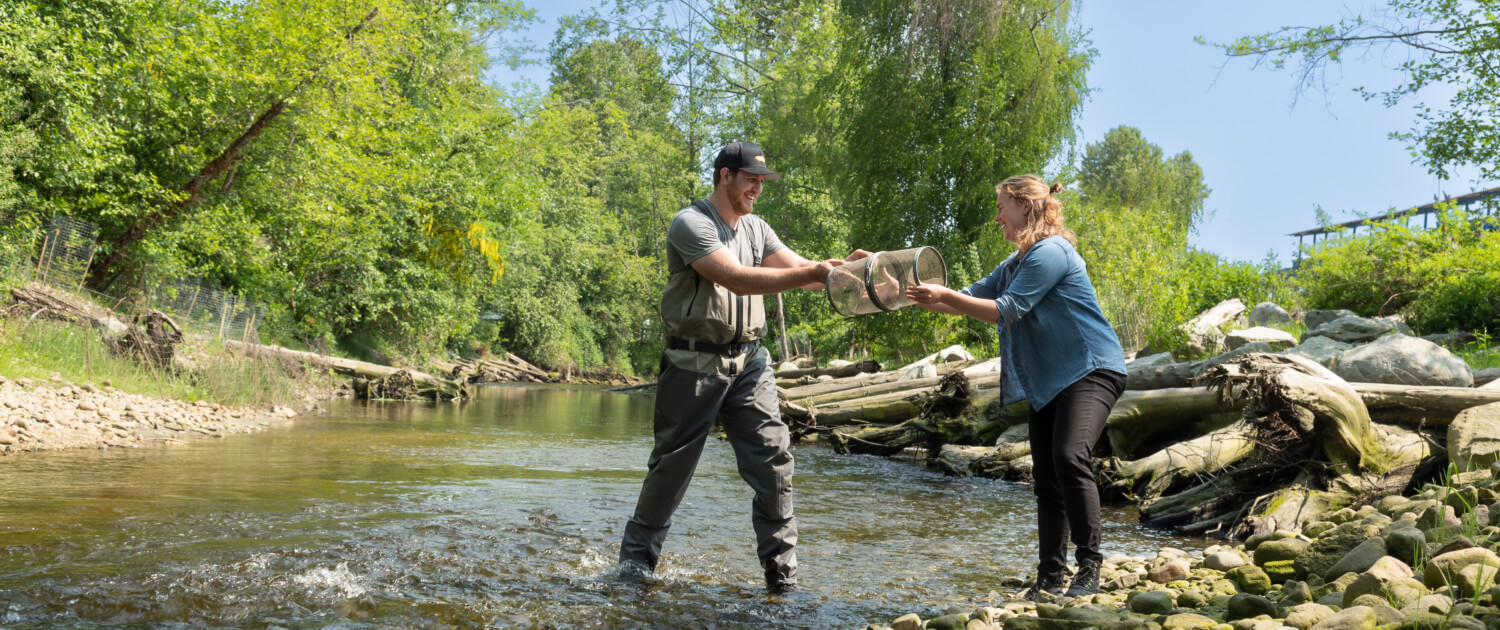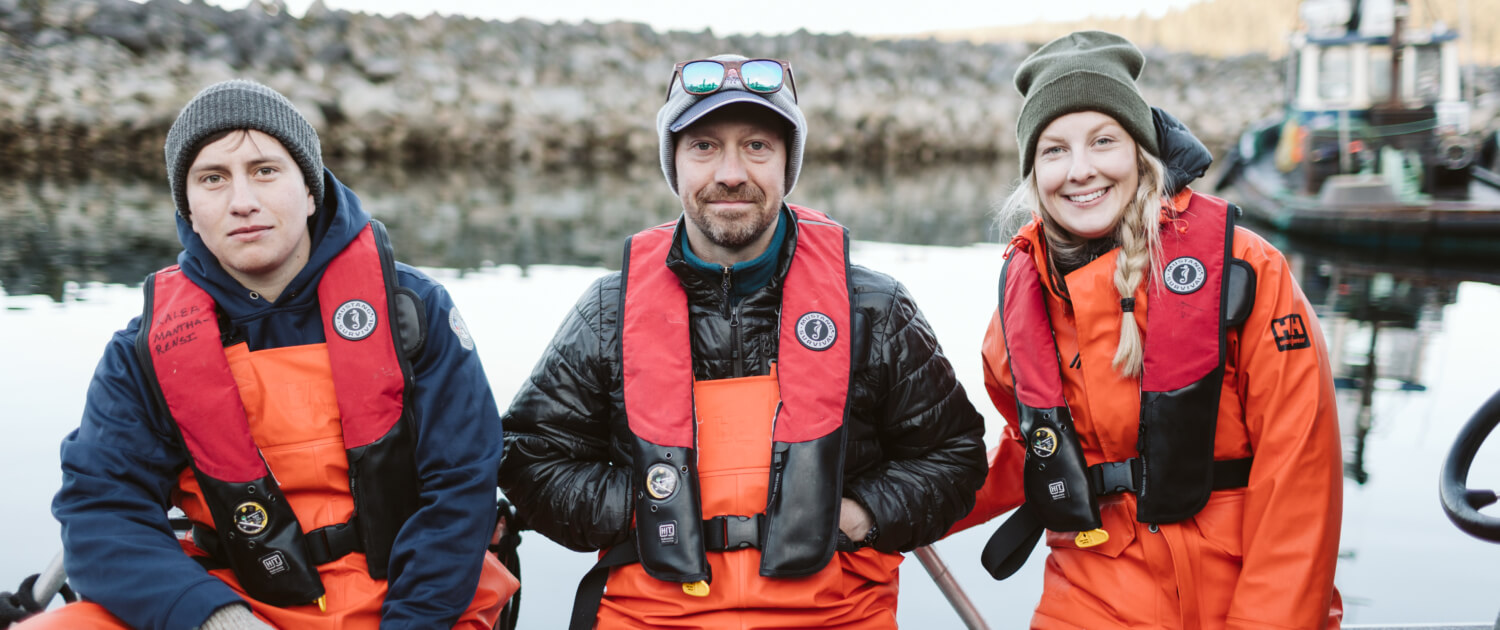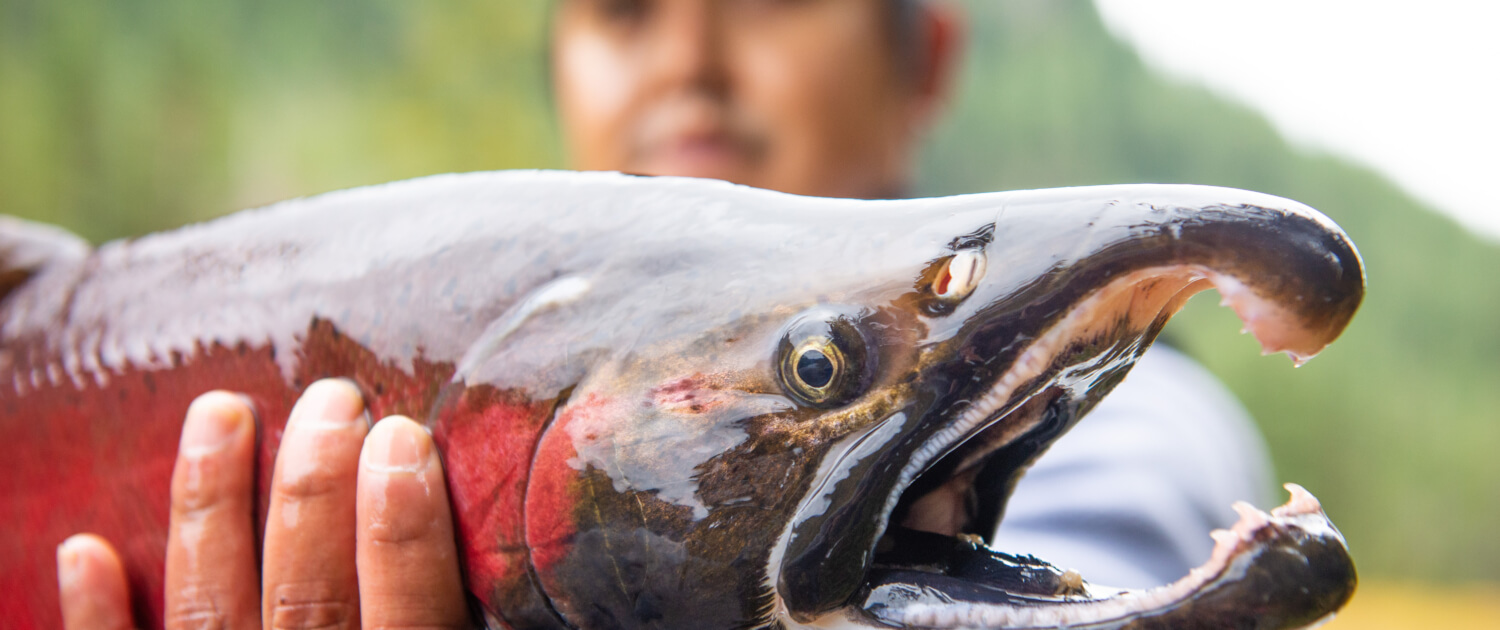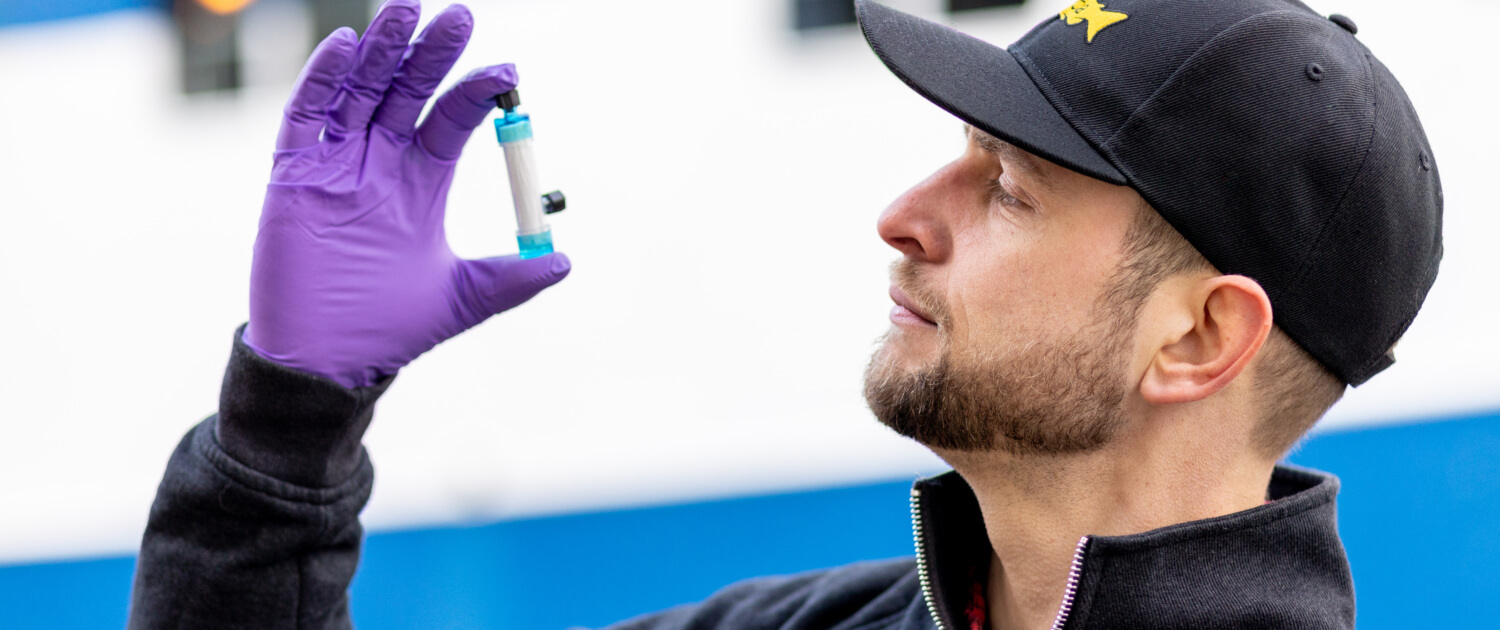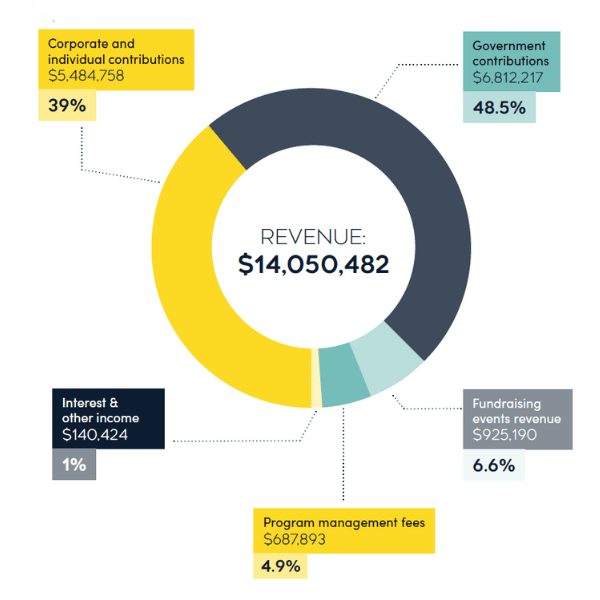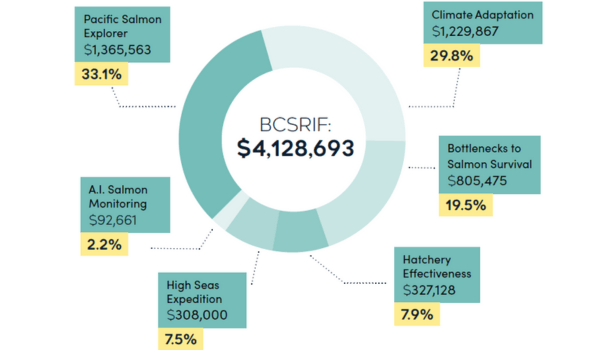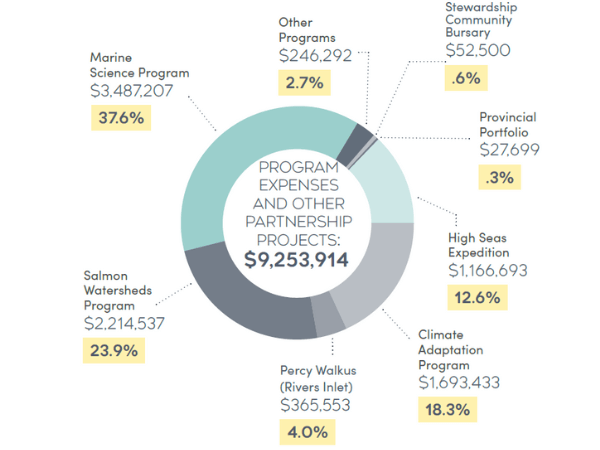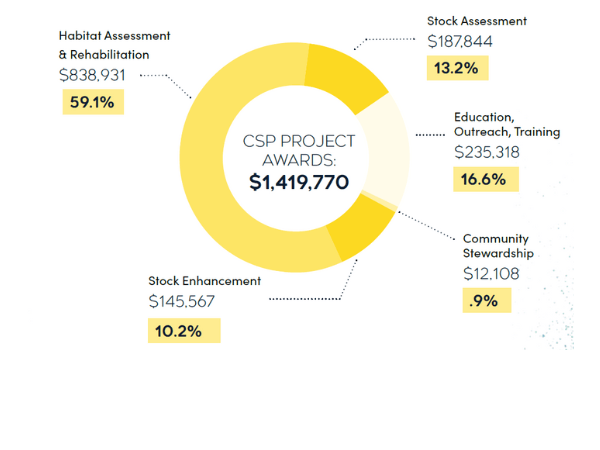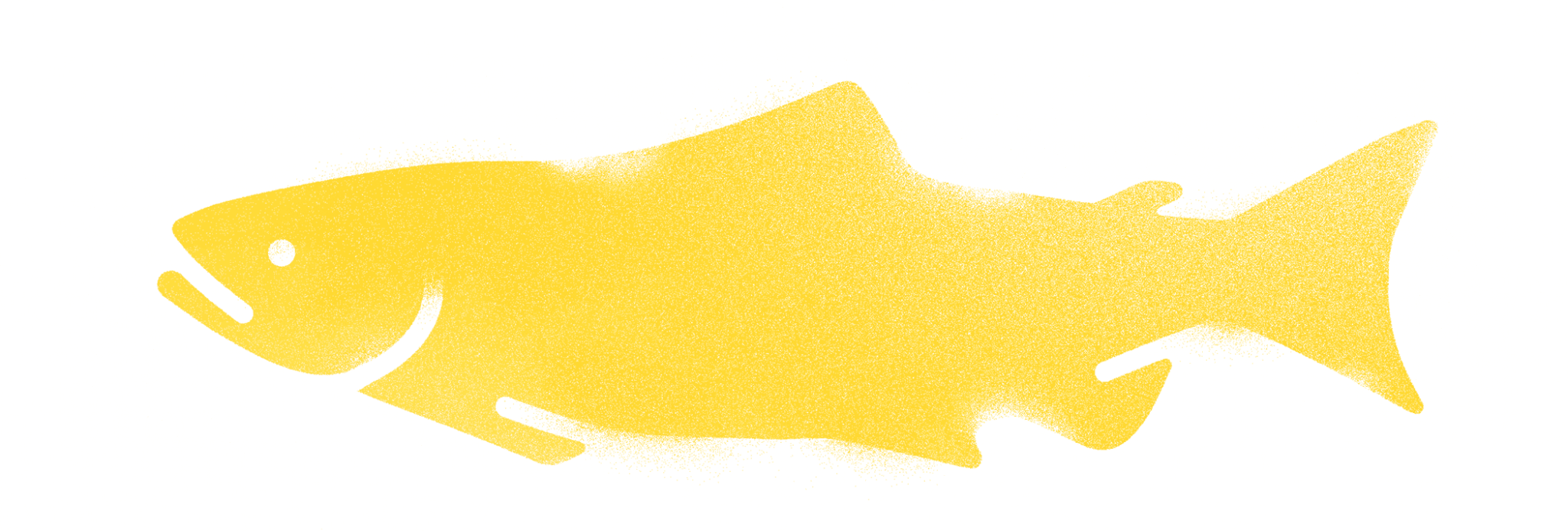From left: Michael Meneer with Hon. Josie Osborne and MLA Bob D’Eith touring the Heart of the Fraser River.
2022: Moving the dial for salmon
The Pacific Salmon Foundation (PSF) was founded on the understanding that the recovery of wild Pacific salmon couldn’t be tackled by government alone. This year, PSF’s work centred on convening First Nations and Crown government leaders, salmon experts, partners, and communities across the province to help facilitate collaboration, coordination, and action for wild salmon recovery.
“This past year we, and salmon, experienced acute climate events that serve as timely reminders that salmon recovery requires our urgent and coordinated attention today – sustained by durable funding into the foreseeable future. And, while salmon continue in a state of decline, we see a confluence of will from the salmon community, governments, and partners increasing efforts to advance salmon recovery. It’s going to take all of us.”
— Michael Meneer, president and CEO Pacific Salmon Foundation
Together with our partners, PSF’s work spans the salmon lifecycle from watersheds to open ocean. We catalyze a broader movement engaging communities, volunteers, and donors to tackle the wide range of issues facing wild Pacific salmon.
We are proud to share with you the highlights from 2022, made possible thanks to our generous donors, government funders, and the Pacific Salmon Foundation Endowment Fund that support PSF’s People for Salmon — those who step up, wade in, and work tirelessly for salmon.
We’re salmon first, salmon always — and we don’t go it alone.
Pacific Salmon Foundation
2022 Highlights
Download Full Report
7.1 MB | 17 Pages | Published: June 2023
2022 Revenue
Revenues by BC Salmon Restoration and Innovation Fund – BCSRIF
Established in 2018 as a partnership between the Government of Canada and the Province of British Columbia, the BC Salmon Restoration and Innovation Fund (BCSRIF) supports protection and restoration activities for Pacific salmon.
Revenue by donations
2022 Expenses
Special thanks to our generous supporters for advancing game-changing work to save and restore wild Pacific salmon.
Marine Science Program
Since the late 1970s, wild Pacific salmon populations in the Salish Sea have mysteriously and sharply declined. Despite conservation efforts, further recovery efforts are needed. PSF’s Marine Science program is committed to understanding the factors that contribute to their decline.
Special thanks to our funders and donors: Fisheries and Oceans Canada, Province of British Columbia, BCSRIF, Environment and Climate Change Canada, Canada’s Climate Action and Awareness Fund, RBC Foundation, and many donors.
Nearshore HabitatKelp BiobankHatchery Effectiveness ReviewStrait of Georgia Data CentreBottlenecks to Survival Citizen ScienceHigh Seas ResearchSalmon HealthFit Chip Technology
Nearshore Habitat
Estuaries and nearshore marine habitats are crucial for juvenile salmon survival. However, these sensitive habitats are often threatened by damaging industrial and recreational activities. The program’s nearshore work helps build better public awareness and provides tools and strategies to better protect these important salmon habitats.
The Resilient Coasts for Salmon team works to raise public awareness of the impacts of climate change and to increase the adoption of nature-based solutions along the east coast of Vancouver Island.
“The goal of the Resilient Coasts for Salmon program is to help Pacific salmon and other species adapt to climate change by preserving and restoring their natural habitat, while at the same time, protecting coastal infrastructure including shoreline homes.”
— Kyla Sheehan, program manager
Partners: Peninsula Streams & Shorelines, Stewardship Centre for BC, World Wildlife Fund-Canada.
In collaboration with: Capital Regional District, Comox Valley Regional District, Esquimalt First Nation, Fish Kissing Weasel Environmental, Gorge Waterway Action Society, Guardians of the Mid-Island Estuary, Hapa Collaborative, Komoks First Nation, Lees & Associates, Northwest Hydraulics Consultants, Project Watersheds, Songhees First Nation, of Esquimalt, World Fisheries Trust, WSP Golder.
22 Public Awareness Events | 6 Community Mapping Workshops | 100 Trained Green Shores® Volunteers | 659 Kilometres of Shoreline Mapped
Kelp Biobank
Research for the future of kelp
The Kelp Biobank project intends to save B.C.’s disappearing kelp forests by preserving the local biodiversity in case some populations become extinct. The PSF-supported team at Simon Fraser University led by Dr. Sherryl Bisgrove has developed a cryogenic freezing technique to store germplasm, or “seed,” of at-risk bull kelp in a biobank.
The seeds could be used to aid restoration efforts and advance research such as identifying kelp populations that may adapt better to survive in warmer waters.
“Kelp forests are a critical habitat for salmon, providing protection and food resources. Given the speed with which some local kelp populations are declining, it is imperative that we act swiftly to protect these important organisms before they are lost forever.” — Isobel Pearsall, PhD, director, Marine Science Program
Partners: Simon Fraser University
Investigating hatchery effectiveness
Investigating hatchery effectiveness
Hatcheries were developed with the aim of enhancing salmon populations and conserving species at risk. While they can support healthy salmon populations, they can also lead to consequences for wild salmon.
To evaluate hatchery effectiveness, the Pacific Salmon Foundation launched the Hatchery Effectiveness Review. The scope of the review includes investigations into hatchery release strategies, interactions between wild and hatchery salmon, and the effectiveness of hatcheries at meeting their objectives.
Results include recommendations and advice for improved hatchery management and production.
Both hatchery and wild salmon survival depend on the conditions they face as juveniles, so release strategies, such as the timing and size of the fish, matter. However, there is no one-size-fits-all solution. Given that salmon populations in B.C. differ in genetics, habitats, and environmental exposures, salmon enhancement strategies need an equally diversified approach. — Sam James, PSF biologist
Photo by Sam James
Chinook fry swim through capped troughs at Capilano River Hatchery
21 CHINOOK and 16 COHO HATCHERIES REVIEWED | 51 YEARS OF ENHANCEMENT DATA
Strait of Georgia Data Centre
MARINE REFERENCE GUIDE
The Strait of Georgia Marine Reference Guide is an online tool that helps people learn about the marine environment in the Strait of Georgia.
The interactive map provides a range of data for informed decision-making that can help a broad range of people from city planners to environmental engineers to bird watchers. Since its official website launch in 2022, the tool is gaining traction among users.
400+ MAPPED DATA LAYERS | 38 EXPERTS FROM 23 ORGANIZATIONS ATTENDED WORKSHOPS | 25 MAPS CREATED | 10,520 ONLINE USERS
Bottlenecks to Survival
With steep declines being observed across many wild Chinook, coho, and steelhead populations in the Salish Sea, it is urgent that we increase our understanding of the factors that may be contributing to the reduced numbers.
The Bottlenecks to Survival Program, a collaboration between PSF and BC Conservation Foundation, investigates when and where Chinook, coho, and steelhead are facing critical mortality periods or “bottlenecks” during the freshwater and early marine periods of life.
ADVANCED TECHNOLOGY HELPS MONITOR RECREATIONAL FISHING CATCH
The Bottlenecks project uses Passive Integrated Transponder (PIT) tags to track salmon survival across their lifecycle. In addition to outfitting rivers on Vancouver Island with PIT detecting arrays and tagging thousands of fish, the team has developed enhanced monitoring cleaning stations.
The stations have been fitted with antennas to detect PIT tags, integrated head depots for Fisheries and Ocean Canada’s Coded Wire Tag recovery program, and video technology. When fish are brought to the cleaning tables, they trigger motion-activated overhead video cameras. Data collected at these enhanced cleaning tables provide valuable supplemental information to DFO’s Creel Survey Program.
“This program provides information that would be unavailable by any other means and contributes to determining survival bottlenecks for salmon in the Salish Sea. With this region being one of the most productive and popular for recreational anglers, greater information on catches will help us understand the contribution of hatcheries, and how best to manage the fishery,” –Will Duguid, University of Victoria postdoctoral research fellow, PSF team lead for Bottlenecks program.
Partners: British Columbia
10 IN-RIVER ARRAYS | 3 ENHANCED MONITORING STATIONS | 200,000 SALMON TAGGED | 2,000 RETURNING ADULT SALMON DETECTED
Citizen Science
Volunteers work as citizen scientists to help collect important information about the salmon food web in the Strait of Georgia. Over the past eight years, Citizen Science has enabled PSF to study the entire Strait of Georgia in real time and continues to be the foundation for three key research initiatives within the Marine Science Program:
- Citizen Science Oceanography Program
- Coho and Chinook Adult Diet Program
- Forage Fish Beach Monitoring
In collaboration with: Mount Arrowsmith Biosphere Region Research Institute, Ocean Networks Canada, University of British Columbia, University of Victoria, Vancouver Island University, World Wildlife Fund – Canada
8 YEARS OF SAMPLING | 200 CITIZEN SCIENTISTS ENGAGED | 50,000 OCEANOGRAPHIC SAMPLES COLLECTED
High Seas Research
SHEDS LIGHT ON OPEN-OCEAN BLACK BOX
The open ocean is the least well-understood bottleneck to the survival of Pacific salmon. Specifically, the first winter at sea is thought to be critical. The Salmon Health Program investigates salmon and ecosystem health throughout the salmon lifecycle, including in the high seas.
As part of the International Year of the Salmon winter expeditions to the Gulf of Alaska and the North Pacific, PSF researchers conducted Fit-Chip screening of salmon pathogens and stressors as well as environmental DNA (eDNA) analysis of the open-ocean ecosystem.
Research findings published in 2022 uncovered new clues relevant to the ongoing declines in some Pacific salmon populations in the open ocean.
The studies reveal how marine heat waves disturb the open-ocean ecosystem and lead to reduced prey availability for Pacific salmon, resulting in poor health. These findings provide new insights into the challenges salmon face under a changing climate and highlight potential remote monitoring and management strategies to protect endangered stocks.
“eDNA analysis is a powerful tool that enables us to detect the genetic signature of organisms living in an environment without capturing them. By extracting genetic material from the water, we can assess biodiversity in aquatic ecosystems from microbes to whales, screen for invasive species or disease agents, and gain valuable insights into the health of the ocean.”—Christoph Deeg, PhD, Salmon Health research team
Special thanks to: Parkland and Canadian Fishing Company
Partners: North Pacific Anadromous Fish Commission, Fisheries and Oceans Canada
942 E-DNA SAMPLES COLLECTED | 636 FIT-CHIP SAMPLES COLLECTED | 2.2 MILLION KILOMETRES OCEAN COVERED
Salmon Health Program
SALMON HEALTH PROGRAM LAUNCHES THANKS TO NORTH FAMILY FOUNDATION GIFT
The Salmon Health Program focuses on three primary areas to help understand and restore salmon:
- Independent Research + Monitoring of Aquaculture: The Salmon Health team conducts research and monitoring related to sea lice and pathogen transfer.
- Broughton Partnership: Under the Mamalilikulla, ’Namgis, and Kwikwasut’inuxw Haxwa’mis First Nations’ Broughton Aquaculture Transition Initiative, PSF monitors fish health on and around salmon farm sites.
- Cumulative Environmental Stressors: The team deploys novel “Fit-Chip” technology to understand the combined impacts of changing environmental conditions on the health and long-term survival of Pacific salmon.
In 2022, experts from the Salmon Health Program testified to Parliament’s Standing Committee on Fisheries and Oceans, and took part in DFO consultations on its commitment to transition away from open-net salmon farming by 2025. The team published peer-reviewed papers in 2022 that helped shed light on the impact disease may have on wild salmon in B.C.
These papers add to a decade of rigorous, peer-reviewed research that has outlined numerous risks open-net pen salmon farms pose to wild Pacific salmon through the amplification and transfer of harmful parasites and pathogens.
“Our peer-reviewed science helps to clarify the disease risks that multiple species of Pacific salmon face. As many wild salmon populations in B.C. have experienced substantial declines over the last three decades, our work suggests that precautionary steps to manage risks under human control — like salmon farms — could play an important role in ensuring a bright future for wild salmon.” — Andrew Bateman, PhD, manager Salmon Health Program
Special thanks to: North Family Foundation, and generous donors and attendees of PSF’s 2022 Vancouver Gala Dinner & Auction
10,000 SAMPLES OVER 10 YEARS | MOUNTING SCIENTIFIC, PEER-REVIEWED EVIDENCE MAKES ONE POINT CLEAR: OPEN-NET PEN SALMON FARMS PRESENT A CLEAR AND UNACCEPTABLE RISK TO B.C.’S WILD PACIFIC SALMON.
NEW TOOLS HELP DELIVER INSIGHTS INTO FISH HEALTH
Dr. Kristi Miller-Saunders, a researcher at DFO, leads a team that studies infectious disease and environmental stress in salmon. Since 2013, PSF has partnered with her lab to develop genomic technology that can clarify the role of environmental stress and disease in salmon.
Using cutting-edge genetic approaches, the Miller lab developed the salmon Fit-Chip that can rapidly draw conclusions about health, stress, and disease in salmon. Fit-Chips offer a powerful technology to understand cumulative stressors in salmon, enabling the team to “ask the fish” whether they have faced a suite of environmental and infectious challenges.
“Through science and new technologies, like the Fit-Chip DNA analysis tool, PSF is well-positioned to influence game-changing action to help bring back wild Pacific salmon through their Salmon Health Program. This is why my family and I have pledged $450,000 toward the program. We believe this research will help us change the game in favour of salmon.” — Rudy North
Special thanks to: North Family Foundation
10,000 SAMPLES OVER 10 YEARS | MOUNTING SCIENTIFIC, PEER-REVIEWED EVIDENCE MAKES ONE POINT CLEAR: OPEN-NET PEN SALMON FARMS PRESENT A CLEAR AND UNACCEPTABLE RISK TO B.C.’S WILD PACIFIC SALMON.
Salmon Watersheds Program
The Salmon Watersheds Program strengthens and provides baseline data on Pacific salmon and their habitats — information crucial for informing evidence-based conservation and management actions.
The program’s work focuses on:
![]()
Democratization of Information
Making Pacific salmon data publicly accessible through interactive online tools.
![]()
Applied Research
Developing and applying new approaches for assessing conservation risks and evaluating management actions for salmon.
![]()
Status Assessments
Completing data-driven assessments of wild Pacific salmonid populations and their habitats.
![]()
Strategic Planning
Supporting partners in developing strategic salmon conservation, restoration, and monitoring plans.
Pacific Salmon Explorer
The Pacific Salmon Explorer provides a common foundation of information for understanding the state of Pacific salmon and their habitats in B.C. This information is essential for identifying conservation and management actions that can help support salmon recovery and resilience.
In 2022, the Columbia River watershed was added to this data visualization tool, adding to the most comprehensive, publicly available resource.
400+ GENETICALLY AND GEOGRAPHICALLY DISTINCT WILD SALMON POPULATIONS | 92% OF B.C.’S POPULATIONS REPRESENTED
Artificial Intelligence to Monitor Salmon
In-season management of salmon fisheries and the recovery of at-risk salmon populations is hindered by a lack of timely information on the number of returning adult salmon. Conducting routine monitoring to guide sustainable fisheries and salmon recovery can be costly, particularly in remote salmon watersheds. Machine learning provides a novel and innovative solution.
This pilot project focuses on developing, testing, and applying computer vision models to empower local and Indigenous-led monitoring and management by supporting expedited in-season processing of salmon counting using videos and sonar cameras.
HOW IT WORKS
- Computer-vision models are developed by scientists to enable rapid, automated detection, tracking, and identification of objects.
- Thousands of frames of prelabelled images or videos are used to ‘train’ the model, teaching it what to look for.
- As the amount of training data increases, the model learns and becomes increasingly reliable at performing this identification task.
- Once the model has been trained and tested, and its accuracy is confirmed, the model can be used to automate counting salmon, especially valuable in remote sites.
Partners: Gitanyow Fisheries Authority, Skeena Fisheries Commission, Haida Fisheries Program, North Coast StAD, Wild Salmon Center, Simon Fraser University
“Heiltsuk has always had a vested interest in their territory and sustainably managing the resources within it. Sockeye has always been a targeted species for food, social, and ceremonial purposes, and Koeye has always been a top producer of sockeye for the community.
However, Heiltsuk had no idea what the overall health of the sockeye stocks were in Koeye, and because it has always been such a dependable system for food production, questions were raised. What is the health of the sockeye population in Koeye? And, what is a sustainable harvest number to ensure that the sockeye population stays stable or booming? Answering these questions was beyond our current capacity, so we developed this partnership to start to answer some of these questions and bring more certainty to management of the sockeye population in Koeye over the long term.” — William Housty, conservation manager, Heiltsuk First Nation
Photo by Mark Cleveland/Gitanyow Fisheries Authority
A coho swims through the Kitwanga River weir and is tracked by the computer vision model.
Technician reviews Yakoun River computer vision images.
Photo by Karl Seitz
The Koeye River weir and counting system.
530,000 LABELED IMAGES | 90% ACCURACY FOR COHO | 15+ COLLABORATORS | 1 OPEN-SOURCE SOFTWARE FOR IDENTIFYING AND COUNTING SALMON
IDENTIFYING THERMAL REFUGIA FOR SALMON
Pacific salmon need cool water to regulate their body functions. Thermal refugia, or discrete cold-water patches in rivers and streams, serve as important areas for salmon to avoid thermal stress. With climate change, the identification and protection of thermal refugia is critical to enabling Pacific salmon to adapt to a rapidly warming climate.
The Salmon Watersheds Program, in partnership with the BC Institute of Technology and Simon Fraser University, is using drones to map the North Alouette River watershed and identify cold-water patches. This information is being used in a broader study funded by the Pacific Institute for Climate Solutions, comparing the effectiveness of different techniques for monitoring thermal refugia.
Partners: BCIT
5,700+ colour and thermal images collected | 8 drone flights | 1 Map of North Alouette River thermal refugia created by drone imagery
Community Salmon Program
The Community Salmon Program, funded primarily by the federal government’s Salmon Conservation Stamp and many individual and corporate donors, provides grants to streamkeepers, First Nations, schools, and conservation organizations — People for Salmon across the province — to save and restore Pacific salmon and their habitats.
Special thanks to all the Community Salmon Program donors: The program is supported by many generous individuals and corporations with shared goals to advance salmon restoration.
2022 supporters include: Methanex, Mosaic Forest Management, Paper Excellence, Pembina Pipeline, Neptune Terminals, Seaspan, Secure Energy, and Trans Mountain, and generous attendees of PSF’s Comox Dinner & Auction.
172 Projects
$1.5+ M Granted
$10 M Value
235000 m² Habitat Restored
Squamish Spit RemovalLynn Creek Off-Channel Habitat RestorationCharters Creek Gravel RestorationNanaimo River Hatchery Upgrade
Squamish Spit Removal
A GAME-CHANGER FOR SALMON
PSF’s Community Salmon Program is proud to be one of the funding partners for the Squamish Spit removal project that aims to restore valuable Chinook salmon habitat in the Squamish River estuary. This spit has long restricted juvenile salmon from accessing the estuary. Its removal will enable young Chinook to grow in the nutrient-rich waters before venturing out to sea.
“The removal of the lower stretch of the Squamish Spit will open up the estuary to out-migrating juvenile Chinook salmon that will be able to enter the rich waters of the estuary to grow into smolts before entering into Howe Sound.” — Edith Tobe, project manager, Squamish River Watershed Society
Special thanks to: Paper Excellence for their $50,000 donation that supports salmon conservation projects like the Squamish Spit removal.
Special thanks to the CSP committee: Dana Atagi, Matt Foy, Jeff Giesbrecht, Molly Hudson, Murray Ned, Kevin Nugent, Martin Paish, Tom Rutherford, Mel Sheng, Hugh Smith, Gord Sterritt, and Shauna Towriss, and DFO advisors Erica Blake and Michael Crowe.
1 FISH PASSAGE RESTORED | 300 HECTARES RECONNECTED HABITAT ACCESS | 10,000 TO 100,000 JUVENILE CHINOOK USING ESTUARY ANNUALLY
LYNN CREEK OFF-CHANNEL HABITAT REHABILITATION
NORTH SHORE STREAMKEEPERS
Climate change is causing juvenile salmon to become stranded by seasonal water flow problems at Lynn Creek, the North Shore’s third-largest salmon bearing river.
To address this, streamkeepers are working on an engineered log jam that will improve water flow conditions, reduce sediment deposition, and result in improved habitat conditions for salmon during warmer and drier periods.
Partners: BCIT, DFO, the District of North Vancouver, North Shore Streamkeepers, Vancouver Fraser Port Authority, and Tsleil-Waututh Nation.
Special thanks to: Seaspan, a long-time generous supporter of the Community Salmon Program, helping to advance salmon conservation work on the North Shore.
150+ METRES OFF-CHANNEL HABITAT ENHANCED | 20 BCIT STUDENT WORKERS
Charters Creek Gravel Restoration
JUAN DE FUCA SALMON RESTORATION SOCIETY
An upstream dam and reservoir, combined with unpredictable seasonal flooding, have resulted in washouts of spawning gravel beds critical for salmon. Volunteers from the Juan de Fuca Salmon Restoration Society are working to strategically maintain and replenish these gravel beds in Charters Creek to ensure sufficient spawning habitat for returning salmon.
Special thanks to: Mosaic Forest Management, a long-time supporter of the Community Salmon Program, helping to advance salmon conservation projects on Vancouver Island.
16-20 CUBIC METRES OF GRAVEL ADDED ANNUALLY | 95 VOLUNTEER HOURS
Nanaimo River Hatchery Upgrade
NANAIMO RIVER STEWARDSHIP SOCIETY
In its quest to help restore threatened salmon stocks, the Nanaimo River Hatchery is leveraging funding to complete necessary upgrades including a new backup generator, aeration tower, raceways, and circular tubs. These upgrades will help ensure that the hatchery can continue to provide a healthy environment for fish production and improved conditions for volunteers.
Special thanks to: Mosaic Forest Management
864 Volunteer Hours
Percy Walkus Hatchery
The Percy Walkus Hatchery plays a key role in conserving salmon at Rivers Inlet in the Central Coast region of British Columbia. Run by the Wuikinuxv Nation and supported by PSF, the hatchery on the Wanukv (Wannock) River has enabled major strides in conserving, restoring, and enhancing the unique Wanukv Chinook as well as Chinook from the nearby Kilbella and Chuckwalla Rivers.
During the summer and fall of 2022, a lack of rain affected Chinook salmon in Wuikinuxv Territory with fewer fish than normal arriving to spawn.
As the first significant storm of the season brought rain, Chinook began to arrive in numbers, but many females were not ready to spawn. Logistically, this involved much more effort than usual. Volunteers alongside staff from Snootli Hatchery, and Duncanby and Good Hope Lodges joined the hatchery crew in the egg takes of the legendary Chinook on the Wanukv River.
Without these generous contributions and the time and expertise of individuals, such a large undertaking would not be possible for this small community-run hatchery.
“As the Percy Walkus Hatchery enters our eighth year of operation, my heart fills with pride and gratitude for all those that have supported us since the dream was born in Rick Hansen’s board room 10 years ago. We are the model for the coast and proof positive of what can be accomplished when First Nations, recreational fishers, science, and DFO come together as one with common goals.” — Sid Keay, Duncanby Lodge
Special thanks to: The Wuikinuxv Nation, Duncanby Lodge & Marina, Good Hope Cannery, DFO, Pacific Salmon Commission and many other donors who help make this hatchery a success.
6,000 EGGS PER FEMALE | 77-POUND MALE CHINOOK | $600,000 RAISED
Climate Adaptation for Salmon
Thanks to a grant from the BC Salmon Restoration and Innovation Fund (BCSRIF), jointly funded by the federal and provincial government, PSF’s Climate Adaptation program works to identify areas where we can help salmon adapt to changing conditions.
The BCSRIF grant focused on the following three projects in 2022:
1. THE FOREST FIRE PLAYBOOK

Wildfires lead to major changes in rivers and streams, destroying habitat, salmon, and their eggs. PSF’s fire recovery playbook explores landscape strategies to mitigate effects from wildfires and accelerate habitat recovery to support salmon. The playbook will be finalized in 2023.
2. GENETIC ADAPTABILITY
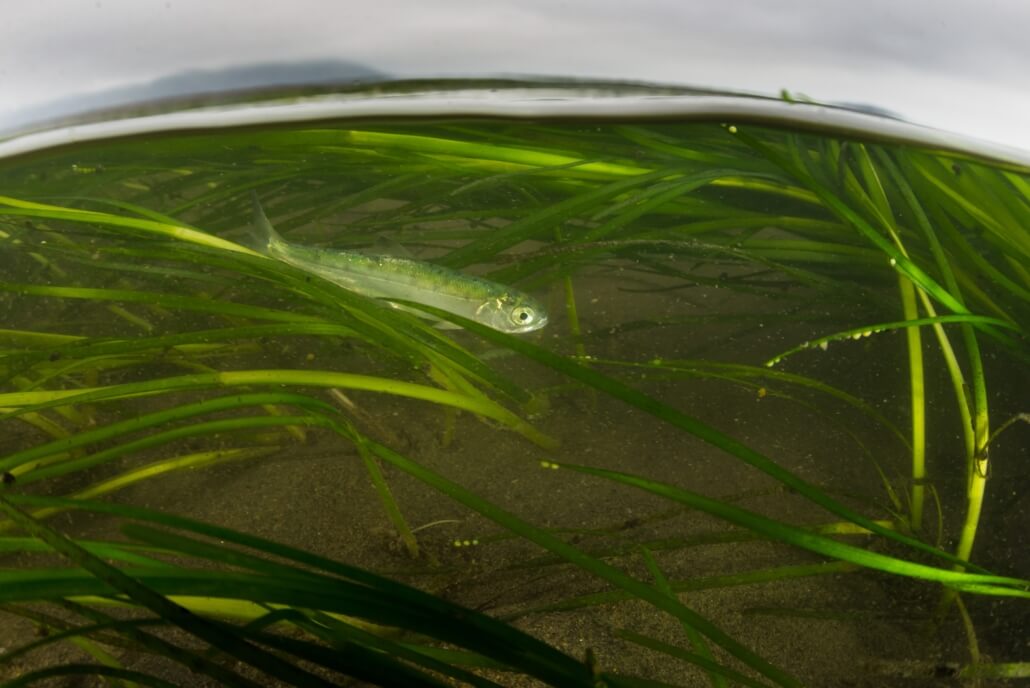
PSF and partners successfully used advanced techniques to investigate genetic differences within Upper Fraser salmon populations and developed tools to improve genetic stock identification. The next stages of analysis are looking for genetic adaptations within populations to inform conservation and rebuilding actions.
3. ASSESSING FRASER RIVER MIGRATION IMPEDIMENTS
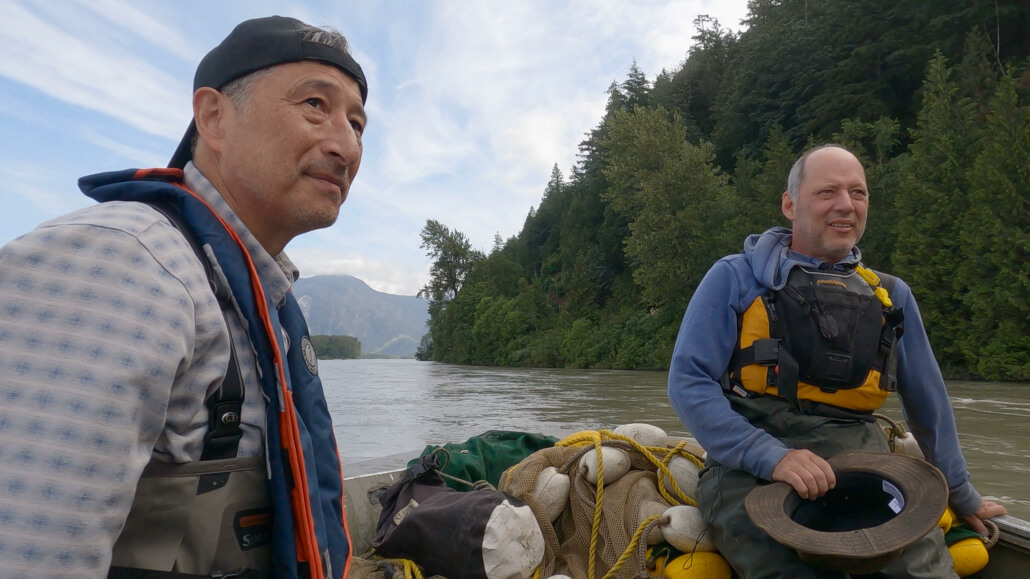
Chinook salmon that spawn in the Upper Fraser have been in decline. PSF and partners tagged early-run Chinook over the springs of 2021 and 2022 to investigate potential migration impediments as these fish swim to their spawning grounds.
Key finding: Chinook delayed migration during the highest flows, but as flows dropped, they were able to continue upstream, indicating that the Lower Fraser Canyon did not present a barrier to migration.
Partners include: Matsqui and Yale First Nations.
173 CHINOOK TAGGED | 7 FIXED RADIO TELEMETRY STATIONS INSTALLED | 23 MOBILE TELEMETRY SURVEYS
Flood Recovery
PEOPLE FOR SALMON WORK TOGETHER FOR COLDWATER RIVER COHO
Throughout 2022, PSF worked with First Nations, government agencies, and partners to assess impacts, identify sites in need of restoration, and secure funding to support flood recovery efforts. As part of ongoing assessment in the Coldwater River, a helicopter flight in November helped identify thousands of adult coho salmon blocked from ideal spawning habitat by a log jam.
A team of experts created a bypass channel around the log jam which enabled fish passage and access to spawning areas upriver. PSF supported work led by Fisheries and Oceans Canada (DFO) and Scw’exmx Tribal Council to swiftly address this problem.
“It was such a feeling of relief to see the numbers of coho that were able to make it up stream and begin to spawn. Everyone came together, made the work happen, and the fish got to where they needed to go.” — Lynda Ritchie, restoration biologist DFO
Special thanks to: $1M grant from the Pacific Salmon Endowment Fund that enabled PSF leadership with partners.
Before: Aerial view of Coldwater River log jam blocking salmon from accessing more than 10 kilometres of spawning habitat.
After: The bypass channel was created. Logs were placed back over top to provide cover and structure, important habitat elements for salmon spawning. Coho successfully used the bypass channel, spawning upstream.
6 KILOMETRES CRITICAL HABITAT ACCESS RESTORED | 1 COLLABORATIVE FRAMEWORK OUTLINE
PACIFIC SALMON ACTION DIALOGUE SERIES
It’s going to take all of us, working together, to save Pacific salmon. This notion of collaboration for the sake of salmon has been the force behind the Pacific Salmon Action Dialogues – a series in collaboration with First Nations Fisheries Council (FNFC) of B.C.
In 2022, PSF and FNFC co-hosted four Dialogue sessions – convening leaders across First Nations, Crown governments, and salmon experts working from the shared belief that salmon are in crisis, and it’s going to take all of us to find a solution. Through the initial Dialogues, unwavering support emerged for the notion that we need a collaborative framework to drive action for salmon. The Dialogues have led to the emergence of a draft declaration and three-scale framework for collaborative salmon recovery developed from participant input.
PSF continues working with FNFC on the next iteration of the collaborative framework, integrating learning from successful models operating in B.C. and other jurisdictions.
Special thanks to: Sitka Foundation
“By partnering as joint conveners in the salmon community, we hope to effectively engage a diverse coalition of leaders including First Nations, federal and provincial governments, conservation non-governmental organizations, and stakeholders. Our goal is to find and initiate a plan of innovative actions to help us all help wild Pacific salmon adapt for the challenges they face now and will continue to face in the future.” — Jordan Point, executive director, First Nations Fisheries Council of B.C.
Pacific Salmon Action Dialogue participants, June 2, 2022
2022 Vancouver Gala
Pacific salmon need our help
The Pacific Salmon Foundation is dedicated to harnessing the passion of people to save and restore wild Pacific salmon, and we never go it alone. Now, more than ever, we depend on the generous support of donors to help save and restore wild Pacific salmon.
In 2022, we welcomed the return to in-person events. We were incredibly grateful to see many of our friends, volunteers, and partners take part in our flagship Vancouver Gala Dinner & Auction, presented by Wheaton Precious Metals as well as our Comox Valley Dinner & Auction.
A highlight of our Vancouver Gala Dinner & Auction was the $500,000 raised thanks to sponsors and donors.
These funds, along with the $450,000 donation from the North Family Foundation, will help advance our Salmon Health Program’s critical research into the cumulative stressors facing salmon.
SALMON SPOTTING
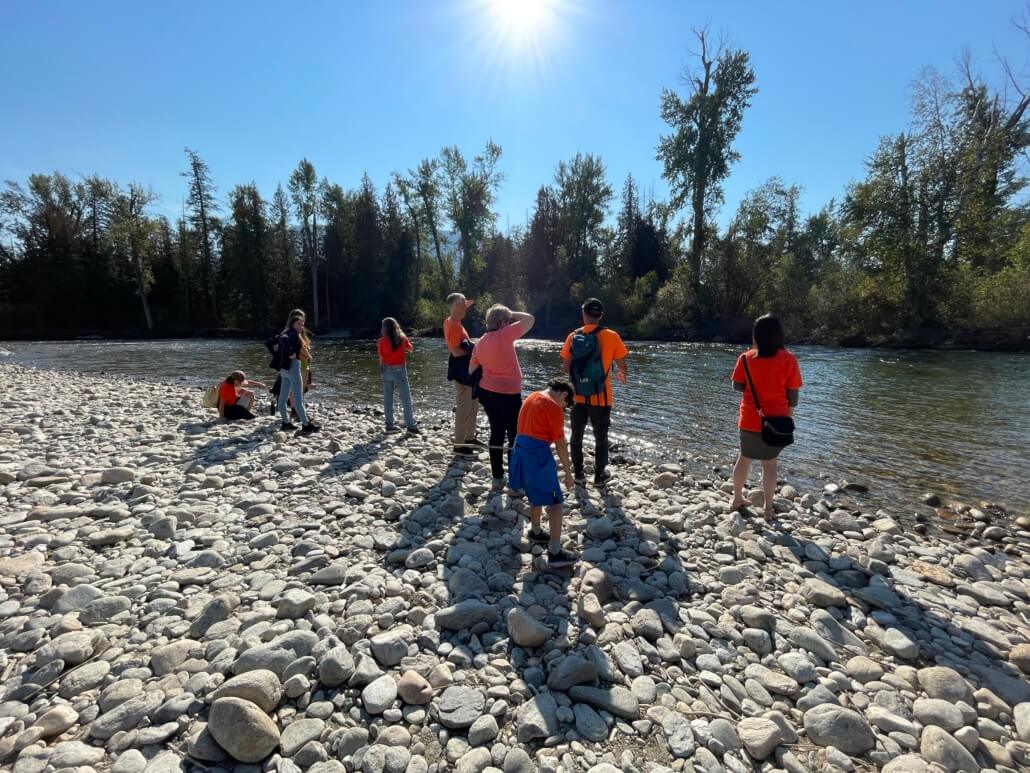
We all need salmon, and the joy of witnessing their migration back to home streams to spawn is a B.C. rite of passage. This fall, our Salmon Spotting campaign welcomed new partners – BC Parks Foundation – and many streamkeepers and conservation community hatcheries who shared the best locations to view the iconic species.
Featured in more than 30 news outlets and boosted by media partner Global BC, the campaign drew thousands of people to see salmon return to their freshwater habitats. In its second year, PSF’s Salmon Spotting campaign launched a new public-access interactive map highlighting more than 80 family-friendly locations to see salmon.
ADAMS RIVER SALUTE TO THE SOCKEYE

The 2022 Salute to the Sockeye festival attracted hundreds of thousands of visitors over a three-week period, celebrating the dominant year for the Adams sockeye. Presented by the Adams River Salmon Society and Little Shuswap Lake Band, the event showcased the remarkable migration of the Adams Lake sockeye as they spawned in the clear channels of Tsútswecw Provincial Park.
Supported by PSF, the festival offered family friendly activities, educational programs, cultural events, local vendors, and opportunities to observe salmon from viewing platforms and trails.
Salmon Spotting
We all need salmon, and the joy of witnessing their migration back to home streams to spawn is a B.C. rite of passage. This fall, our Salmon Spotting campaign welcomed new partners – BC Parks Foundation – and many streamkeepers and conservation community hatcheries who shared the best locations to view the iconic species.
Featured in more than 30 news outlets and boosted by media partner Global BC, the campaign drew thousands of people to see salmon return to their freshwater habitats. In its second year, PSF’s Salmon Spotting campaign launched a new public-access interactive map highlighting more than 80 family-friendly locations to see salmon.
Photo by Braela Kwan
People viewing salmon at the Adams River, September 30, 2022
Adams River Salute to the Sockeye
The 2022 Salute to the Sockeye festival attracted hundreds of thousands of visitors over a three-week period, celebrating the dominant year for the Adams sockeye. Presented by the Adams River Salmon Society and Little Shuswap Lake Band, the event showcased the remarkable migration of the Adams Lake sockeye as they spawned in the clear channels of Tsútswecw Provincial Park. Supported by PSF, the festival offered family friendly activities, educational programs, cultural events, local vendors, and opportunities to observe salmon from viewing platforms and trails.
Adams River Rehabilitation
A de-watered channel on the Adams River, which serves as a crucial spawning ground for sockeye, was successfully restored last fall just in time for spawning. Adams River sockeye, traveling up to 2,000 kilometers from the Pacific Ocean through the Fraser and Thompson Rivers, rely on side channels for spawning. However, changes in river flows and the accumulation of gravel and debris had obstructed these important habitats.
Satellite and imagery calculations by DFO revealed that the lower portion of the Adams River had lost between 33 to 50 percent of optimal spawning habitat.
To address this issue, the Pacific Salmon Foundation contributed $139,000 in 2020 to support a two-year habitat restoration project.
Led by the DFO Habitat Restoration team, the effort involved the collaboration of the Little Shuswap Lake First Nation, BC Parks, and local contractors.
The project successfully cleared debris from the side channels and utilized natural materials to stabilize the river bank.
“Salmon is more than just a food source, it’s a way of life for our people. Our connection to the land and water is through the salmon. We have a responsibility to protect and conserve this sacred species for our future generations. The salmon bring life to our rivers, nourishment to our bodies, and serve as a symbol of our culture and traditions. It is our duty to work together to ensure the survival of the salmon and the ecosystems that support them.” — Kukpi7 (Chief) James Tomma, Skwlāx te Secwepemcul̓ecw (previously known as Little Shuswap Indian Band)
Adams River
Adams River before and after restoration work
$139,000 FOR ADAMS RIVER REHABILITATION WORK | $50,000 FOR THE SALUTE TO THE SOCKEYE FESTIVAL
PROVINCIAL FUNDS ENABLE GAME-CHANGING PROJECTS
In 2019, the Province of British Columbia granted $5 million to the Pacific Salmon Foundation to support Pacific salmon restoration initiatives. The Pacific Salmon Foundation is grateful to steward these funds for salmon across their lifecycle from watersheds, to hatcheries, to the Gulf of Alaska.
Thank You!
Thank you to our generous supporters for advancing game-changing work to save and restore wild Pacific salmon.
